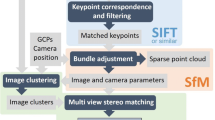Abstract
Data collected along transects are becoming more common in environmental studies as indirect measurement devices, such as geophysical sensors, that can be attached to mobile platforms become more prevalent. Because exhaustive sampling is not always possible under constraints of time and costs, geostatistical interpolation techniques are used to estimate unknown values at unsampled locations from transect data. It is known that outlying observations can receive significantly greater ordinary kriging weights than centrally located observations when the data are contiguously aligned along a transect within a finite search window. Deutsch (1994) proposed a kriging algorithm, finite domain kriging, that uses a redundancy measure in place of the covariance function in the data-to-data kriging matrix to address the problem of overweighting the outlying observations. This paper compares the performances of two kriging techniques, ordinary kriging (OK) and finite domain kriging (FDK), on examining unexploded ordnance (UXO) densities by comparing prediction errors at unsampled locations. The impact of sampling design on object count prediction is also investigated using data collected from transects and at random locations. The Poisson process is used to model the spatial distribution of UXO for three 5000 × 5000 m fields; one of which does not have any ordnance target (homogeneous field), while the other two sites have an ordnance target in the center of the site (isotropic and anisotropic fields). In general, for a given sampling transects width, the differences between OK and FDK in terms of the mean error and the mean square error are not significant regardless of the sampled area and the choice of the field. When 20% or more of the site is sampled, the estimation of object counts is unbiased on average for all three fields regardless of the choice of the transect width and the choice of the kriging algorithm. However, for non-homogeneous fields (isotropic and anisotropic fields), the mean error fluctuates considerably when a small number of transects are sampled. The difference between the transect sampling and the random sampling in terms of prediction errors becomes almost negligible if more than 20% of the site is sampled. Overall, FDK is no better than OK in terms of the prediction performances when the transect sampling procedure is used.
Similar content being viewed by others
Acknowledgments.
The authors would like to thank Orlando Garcia for developing C codes to perform transect sampling and Ray Finely for his review and insightful comments. This manuscript was substantially improved by comments from two anonymous reviewers. This study was financially supported by the Strategic Environmental Research and Development Program (SERDP) UXO Cleanup program under grant UX-1200. Sandia is a multiprogram laboratory operated by Sandia Corporation, a Lockheed Martin Company, for the United States Department of Energy’s National Nuclear Security Administration under contract DE-AC04–94AL85000.
Author information
Authors and Affiliations
Corresponding author
Rights and permissions
About this article
Cite this article
Saito, H., McKenna, S., Zimmerman, D. et al. Geostatistical interpolation of object counts collected from multiple strip transects: Ordinary kriging versus finite domain kriging. Stoch Environ Res Ris Assess 19, 71–85 (2005). https://doi.org/10.1007/s00477-004-0207-3
Issue Date:
DOI: https://doi.org/10.1007/s00477-004-0207-3




